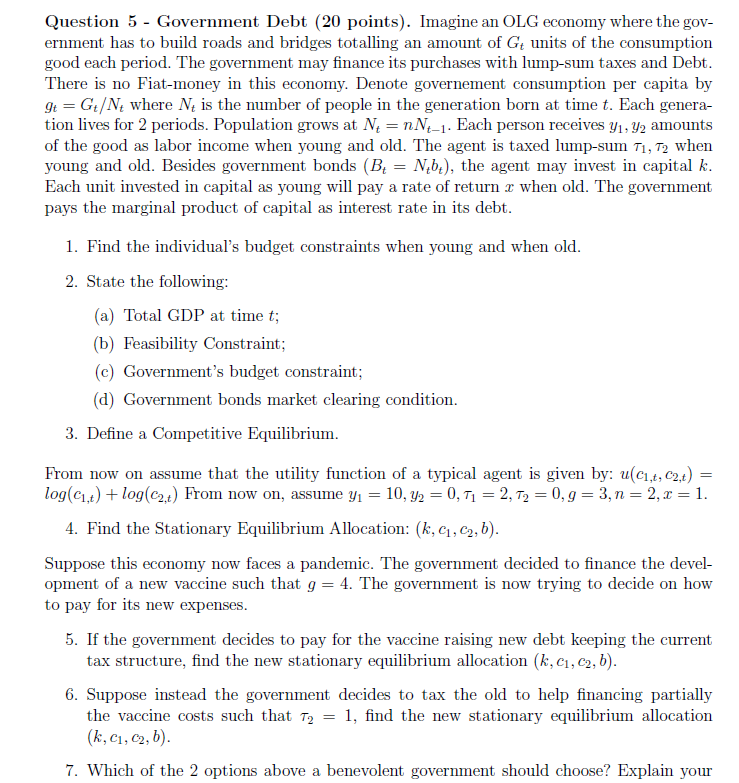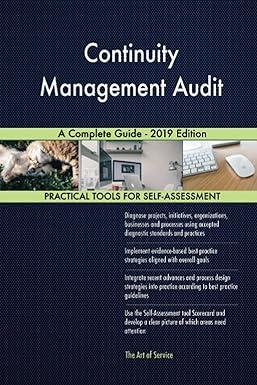
Question 5 - Government Debt (20 points). Imagine an OLG economy where the gov- ernment has to build roads and bridges totalling an amount of G4 units of the consumption good each period. The government may finance its purchases with lump-sum taxes and Debt. There is no Fiat-money in this economy. Denote governement consumption per capita by It = G4/N where N is the number of people in the generation born at time t. Each genera- tion lives for 2 periods. Population grows at N= nN-1. Each person receives y1, y2 amounts of the good as labor income when young and old. The agent is taxed lump-sum T1, T2 when young and old. Besides government bonds (B; = N b), the agent may invest in capital k. Each unit invested in capital as young will pay a rate of return = when old. The government pays the marginal product of capital as interest rate in its debt. 1. Find the individual's budget constraints when young and when old. 2. State the following: (a) Total GDP at time t; (b) Feasibility Constraint; (c) Government's budget constraint; (d) Government bonds market clearing condition. 3. Define a Competitive Equilibrium. = From now on assume that the utility function of a typical agent is given by: u(C1,4,C2,t) log(C1,t) + log(C2,4) From now on, assume y = 10, y2 = 0,T1 = 2,72 = 0,9 = 3, n = 2, 2 =1. 4. Find the Stationary Equilibrium Allocation: (k,C1,C2,6). Suppose this economy now faces a pandemic. The government decided to finance the devel- opment of a new vaccine such that g = 4. The government is now trying to decide on how to pay for its new expenses. 5. If the government decides to pay for the vaccine raising new debt keeping the current tax structure, find the new stationary equilibrium allocation (k,C1,C2, b). 6. Suppose instead the government decides to tax the old to help financing partially the vaccine costs such that T2 = 1, find the new stationary equilibrium allocation (k, ci, c2, b). 7. Which of the 2 options above a benevolent government should choose? Explain your Question 5 - Government Debt (20 points). Imagine an OLG economy where the gov- ernment has to build roads and bridges totalling an amount of G4 units of the consumption good each period. The government may finance its purchases with lump-sum taxes and Debt. There is no Fiat-money in this economy. Denote governement consumption per capita by It = G4/N where N is the number of people in the generation born at time t. Each genera- tion lives for 2 periods. Population grows at N= nN-1. Each person receives y1, y2 amounts of the good as labor income when young and old. The agent is taxed lump-sum T1, T2 when young and old. Besides government bonds (B; = N b), the agent may invest in capital k. Each unit invested in capital as young will pay a rate of return = when old. The government pays the marginal product of capital as interest rate in its debt. 1. Find the individual's budget constraints when young and when old. 2. State the following: (a) Total GDP at time t; (b) Feasibility Constraint; (c) Government's budget constraint; (d) Government bonds market clearing condition. 3. Define a Competitive Equilibrium. = From now on assume that the utility function of a typical agent is given by: u(C1,4,C2,t) log(C1,t) + log(C2,4) From now on, assume y = 10, y2 = 0,T1 = 2,72 = 0,9 = 3, n = 2, 2 =1. 4. Find the Stationary Equilibrium Allocation: (k,C1,C2,6). Suppose this economy now faces a pandemic. The government decided to finance the devel- opment of a new vaccine such that g = 4. The government is now trying to decide on how to pay for its new expenses. 5. If the government decides to pay for the vaccine raising new debt keeping the current tax structure, find the new stationary equilibrium allocation (k,C1,C2, b). 6. Suppose instead the government decides to tax the old to help financing partially the vaccine costs such that T2 = 1, find the new stationary equilibrium allocation (k, ci, c2, b). 7. Which of the 2 options above a benevolent government should choose? Explain your







